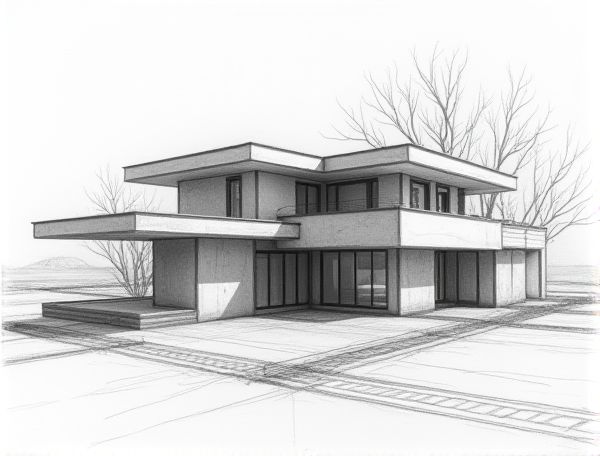
Photo illustration: Deconstructivist home design with non-linear geometry
Deconstructivist home design challenges traditional architectural forms by incorporating non-linear geometry, creating dynamic, fragmented spaces that reflect complexity and unpredictability. Explore how this innovative style can transform Your living environment by reading more in the article.
Introduction to Deconstructivist Home Design
Deconstructivist home design challenges traditional architectural norms by embracing fragmented forms, non-linear shapes, and an intentional sense of disorder to create visually dynamic living spaces. Your home can showcase innovative aesthetics through asymmetry, unpredictability, and the juxtaposition of unconventional materials, redefining modern residential architecture.
Key Principles of Non-Linear Geometry in Architecture
Non-linear geometry in architecture enhances home design by creating dynamic, organic forms that break away from traditional straight lines, offering unique spatial experiences. Your living space benefits from increased visual interest and structural innovation through curves, angles, and complex geometries that optimize both aesthetics and functionality.
Historical Evolution of Deconstructivist Architecture
Deconstructivist architecture originated in the late 20th century, influenced by postmodern philosophy and avant-garde art, challenging traditional design principles with fragmented forms and dynamic structures. Your home design can embrace this style by incorporating asymmetry, non-rectilinear shapes, and unconventional materials that reflect the movement's evolution from architects like Frank Gehry and Zaha Hadid.
Influential Architects in Deconstructivist Design
Deconstructivist design pioneers like Frank Gehry, Zaha Hadid, and Daniel Libeskind revolutionized home architecture with fragmented forms and unconventional geometries that challenge traditional structures. Their innovative use of asymmetry and non-linear shapes creates dynamic, visually striking residences that reflect individuality and artistic expression. Incorporating elements inspired by these influential architects can elevate your home design with cutting-edge aesthetics and bold spatial concepts.
Distinctive Features of Non-Linear Home Layouts
Non-linear home layouts incorporate organic shapes and fluid spatial arrangements that break the monotony of traditional rectangular designs, enhancing both aesthetic appeal and functional flow. Curved walls, angled rooms, and varying ceiling heights create unique visual interest and optimize natural light distribution throughout your living space. These distinctive features foster a dynamic environment, promoting creativity while maximizing comfort and privacy.
Material Selection for Deconstructivist Homes
Material selection for deconstructivist homes emphasizes unconventional and contrasting textures such as steel, glass, concrete, and reclaimed wood to highlight fragmented forms and dynamic shapes. Using durable, sustainable materials supports both aesthetic appeal and environmental responsibility, ensuring structural integrity in complex geometries. Innovative finishes like matte metals and translucent panels enhance the visual tension and asymmetry emblematic of deconstructivist architecture.
How Non-Linear Geometry Impacts Interior Spaces
Non-linear geometry transforms interior spaces by introducing organic curves and dynamic forms that enhance spatial flow and visual interest, breaking away from traditional rectangular layouts. This approach fosters unique, multifunctional environments that optimize natural light distribution and create a sense of movement within the home.
Challenges in Building Deconstructivist Residences
Designing deconstructivist residences poses challenges such as integrating unconventional geometric forms with structural stability and ensuring that non-linear spaces maintain functionality and comfort. Architects must also address complex material selections and construction techniques to realize the fragmented, dynamic aesthetics characteristic of deconstructivism.
Sustainability Considerations in Non-Linear Homes
Incorporating renewable materials and energy-efficient systems enhances sustainability considerations in non-linear homes, reducing environmental impact while maximizing resource conservation. Your design can integrate passive solar heating, rainwater harvesting, and green roofs to promote eco-friendly living and long-term energy savings.
Inspiring Examples of Deconstructivist Home Designs
Deconstructivist home designs challenge traditional architectural conventions through fragmented shapes, unconventional angles, and dynamic forms that create visually striking structures. Prominent examples, such as Frank Gehry's Casa da Musica and Zaha Hadid's Vitra Fire Station, exemplify how disjointed components integrate into cohesive yet unpredictable spaces. Your home can embody this bold aesthetic by incorporating asymmetry and innovative materials that evoke movement and complexity.
 homedesy.com
homedesy.com